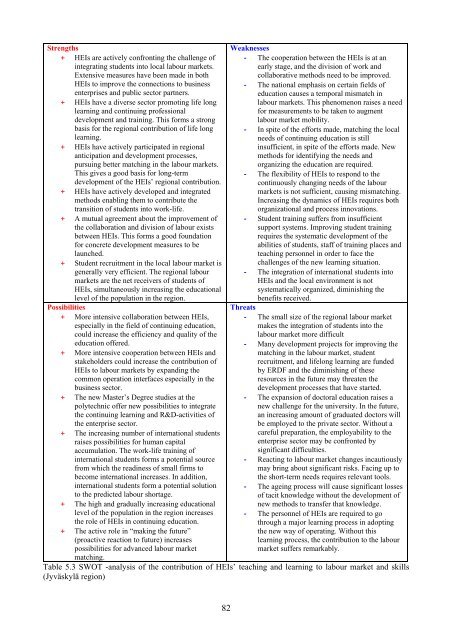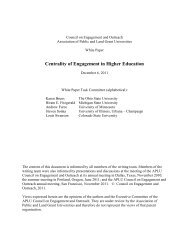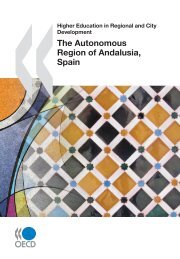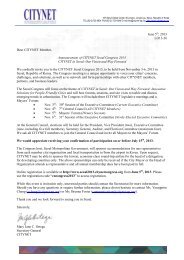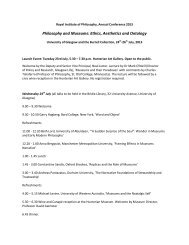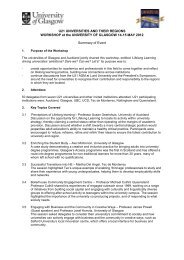Finland - Jyvaskyla Region - Final Self-Evaluation Report.pdf
Finland - Jyvaskyla Region - Final Self-Evaluation Report.pdf
Finland - Jyvaskyla Region - Final Self-Evaluation Report.pdf
You also want an ePaper? Increase the reach of your titles
YUMPU automatically turns print PDFs into web optimized ePapers that Google loves.
Strengths+ HEIs are actively confronting the challenge ofintegrating students into local labour markets.Extensive measures have been made in bothHEIs to improve the connections to businessenterprises and public sector partners.+ HEIs have a diverse sector promoting life longlearning and continuing professionaldevelopment and training. This forms a strongbasis for the regional contribution of life longlearning.+ HEIs have actively participated in regionalanticipation and development processes,pursuing better matching in the labour markets.This gives a good basis for long-termdevelopment of the HEIs’ regional contribution.+ HEIs have actively developed and integratedmethods enabling them to contribute thetransition of students into work-life.+ A mutual agreement about the improvement ofthe collaboration and division of labour existsbetween HEIs. This forms a good foundationfor concrete development measures to belaunched.+ Student recruitment in the local labour market isgenerally very efficient. The regional labourmarkets are the net receivers of students ofHEIs, simultaneously increasing the educationallevel of the population in the region.Possibilities+ More intensive collaboration between HEIs,especially in the field of continuing education,could increase the efficiency and quality of theeducation offered.+ More intensive cooperation between HEIs andstakeholders could increase the contribution ofHEIs to labour markets by expanding thecommon operation interfaces especially in thebusiness sector.+ The new Master’s Degree studies at thepolytechnic offer new possibilities to integratethe continuing learning and R&D-activities ofthe enterprise sector.+ The increasing number of international studentsraises possibilities for human capitalaccumulation. The work-life training ofinternational students forms a potential sourcefrom which the readiness of small firms tobecome international increases. In addition,international students form a potential solutionto the predicted labour shortage.+ The high and gradually increasing educationallevel of the population in the region increasesthe role of HEIs in continuing education.+ The active role in “making the future”(proactive reaction to future) increasespossibilities for advanced labour marketWeaknesses‐ The cooperation between the HEIs is at anearly stage, and the division of work andcollaborative methods need to be improved.‐ The national emphasis on certain fields ofeducation causes a temporal mismatch inlabour markets. This phenomenon raises a needfor measurements to be taken to augmentlabour market mobility.‐ In spite of the efforts made, matching the localneeds of continuing education is stillinsufficient, in spite of the efforts made. Newmethods for identifying the needs andorganizing the education are required.‐ The flexibility of HEIs to respond to thecontinuously changing needs of the labourmarkets is not sufficient, causing mismatching.Increasing the dynamics of HEIs requires bothorganizational and process innovations.‐ Student training suffers from insufficientsupport systems. Improving student trainingrequires the systematic development of theabilities of students, staff of training places andteaching personnel in order to face thechallenges of the new learning situation.‐ The integration of international students intoHEIs and the local environment is notsystematically organized, diminishing thebenefits received.Threats‐ The small size of the regional labour marketmakes the integration of students into thelabour market more difficult‐ Many development projects for improving thematching in the labour market, studentrecruitment, and lifelong learning are fundedby ERDF and the diminishing of theseresources in the future may threaten thedevelopment processes that have started.‐ The expansion of doctoral education raises anew challenge for the university. In the future,an increasing amount of graduated doctors willbe employed to the private sector. Without acareful preparation, the employability to theenterprise sector may be confronted bysignificant difficulties.‐ Reacting to labour market changes incautiouslymay bring about significant risks. Facing up tothe short-term needs requires relevant tools.‐ The ageing process will cause significant lossesof tacit knowledge without the development ofnew methods to transfer that knowledge.‐ The personnel of HEIs are required to gothrough a major learning process in adoptingthe new way of operating. Without thislearning process, the contribution to the labourmarket suffers remarkably.matching.Table 5.3 SWOT -analysis of the contribution of HEIs’ teaching and learning to labour market and skills(Jyväskylä region)82


